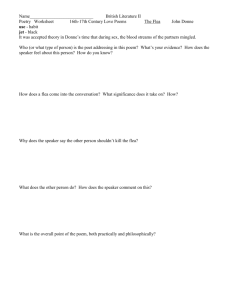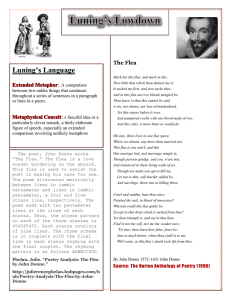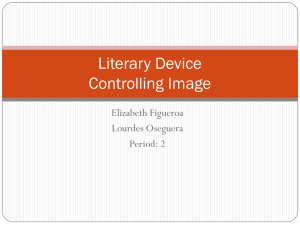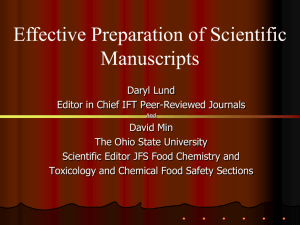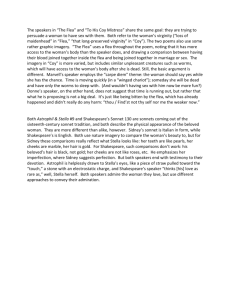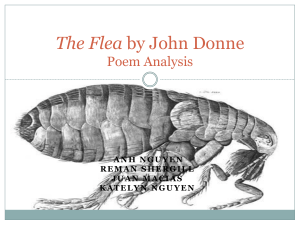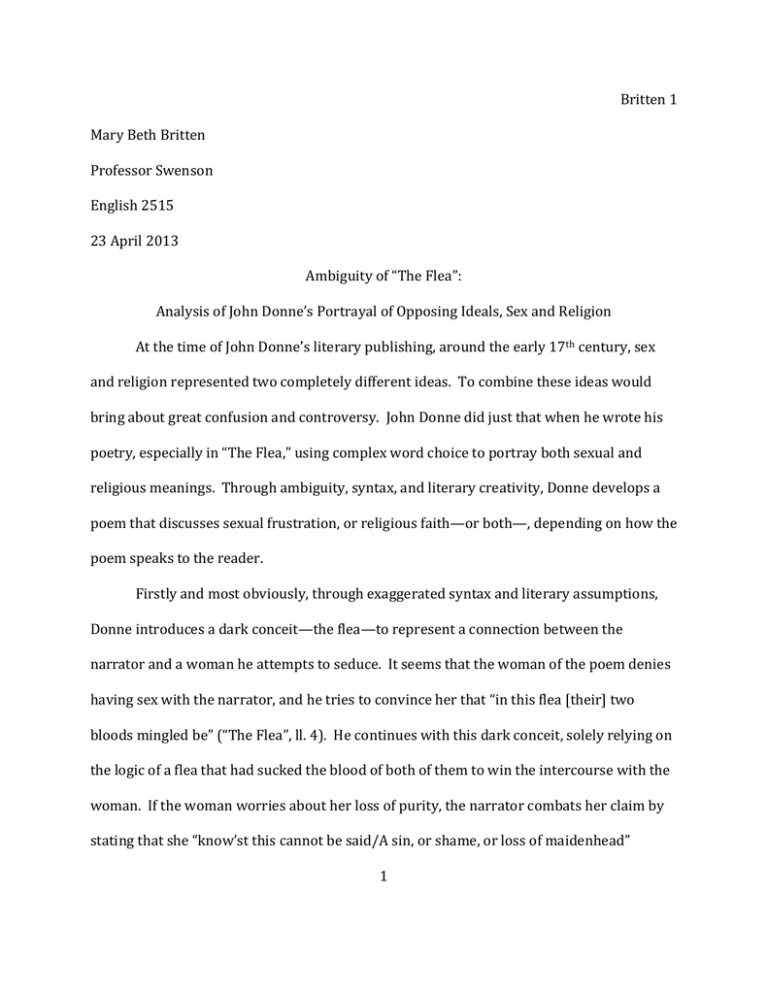
Britten 1
Mary Beth Britten
Professor Swenson
English 2515
23 April 2013
Ambiguity of “The Flea”:
Analysis of John Donne’s Portrayal of Opposing Ideals, Sex and Religion
At the time of John Donne’s literary publishing, around the early 17th century, sex
and religion represented two completely different ideas. To combine these ideas would
bring about great confusion and controversy. John Donne did just that when he wrote his
poetry, especially in “The Flea,” using complex word choice to portray both sexual and
religious meanings. Through ambiguity, syntax, and literary creativity, Donne develops a
poem that discusses sexual frustration, or religious faith—or both—, depending on how the
poem speaks to the reader.
Firstly and most obviously, through exaggerated syntax and literary assumptions,
Donne introduces a dark conceit—the flea—to represent a connection between the
narrator and a woman he attempts to seduce. It seems that the woman of the poem denies
having sex with the narrator, and he tries to convince her that “in this flea [their] two
bloods mingled be” (“The Flea”, ll. 4). He continues with this dark conceit, solely relying on
the logic of a flea that had sucked the blood of both of them to win the intercourse with the
woman. If the woman worries about her loss of purity, the narrator combats her claim by
stating that she “know’st this cannot be said/A sin, or shame, or loss of maidenhead”
1
Britten 2
because their bloods already mingle within the flea (“The Flea”, ll. 5-6). This creative idea
that a flea can contain the blood of a man and a woman, thus sexually combining the two
persons, continues throughout the poem—helping to add support to the narrator’s
argument for sexual relations with the woman.
Because they both have bites from the same flea, “three lives in one flea
spare,/Where [they] almost, nay more than, married are,” rationalizing their seemingly
inevitable marriage and assumed sexual intercourse through the mingling of their blood
(“The Flea”, ll. 10-11). The narrator claims three lives within the flea, being him and her,
“and this [their] marriage bed and marriage temple,” all three lives acting as a connection
between the man and the woman (“The Flea”, ll. 12-13). Though the narrator admits that
their love “cloister[s] in these living walls of jet” within the flea, he holds on to this
entrapment of blood as a justification of their necessary rendezvous (“The Flea”, ll. 15).
The narrator, then, supports this justification by informing the pursued woman that if she
kills the flea she commits three sins by commenting, “Though use make you apt to kill
me,/Let not, to that, self-murder added be,/And sacrilege, three sings in killing three,”
implying the death of him, of her, and of their marriage (“The Flea”, ll. 16-18). Though he
warns her not to, she kills the flea in the end. The narrator then “learn[s] how false fears
be,” realizing that she never worries about her purity being corrupted by the intermingling
blood within the flea (“The Flea”, ll. 25). The narrator gives up his argument for the flea
acting as a gateway for sexual intercourse with the woman, seeing that “so much honor,
when thou yield’st to me,/will waste” his time and motivation (“The Flea”, ll.25-26). He
2
Britten 3
concludes his sexual resignation by declaring that the “flea’s death took life from [the
woman],” so his pursuit for her comes to an end (“The Flea”, ll. 27).
Secondly, and perhaps less obviously, John Donne uses literary creativity to
introduce the same dark conceit—the flea—, which represents a bond between Jesus Christ
and all men. This idea calls for the flea to symbolize Jesus, thus demonstrating that any
worldly thing—even a flea—can symbolize notions of Jesus Christ and the next world. The
first line of the poem reads, “Mark but this flea, and mark in this,” possibly referring to the
Gospel of Mark in which John the Baptist baptizes Jesus, and Jesus resurrects from death
(“The Flea”, ll. 1). The “pamper’d swells with one blood made of two” signifies the flea
injecting the blood of Jesus into man, connecting all men on Earth as one in the Lord (“The
Flea”, ll. 8). In Donne’s era, the church—the people of the church—and God combine into a
marriage, and the narrator explores this idea by stating, “This flea is you and I, and
this/Our marriage bed and marriage temple is” (“The Flea”, ll. 12-13). The flea helps in
mingling the blood of Christ and the blood of man—the Eucharistic Communion—thus
engaging man in Holy marriage through Christ.
When speaking of killing the flea, which symbolizes Jesus, in the third stanza, the
narrator describes Jesus’ death on the cross as “Purpl[ing] thy nail in blood of innocence,”
emphasizing the blameless, immaculate Jesus Christ (“The Flea”, ll. 20). The narrator asks,
“Wherein could this flea guilty be,” wondering how Jesus dies so graciously when he does
not deserve death (“The Flea”, ll. 21). The only guilt or sin that Jesus claims as his own
derive from “that drop which [the flea] suck’d from thee,” meaning Jesus took all of man’s
3
Britten 4
sins as his own, thereby dying innocently (“The Flea”, ll. 22). As Jesus Christ died for the
sins of men, his death took a small portion of life from the world. Donne supports this
claim by confirming that the “flea’s death took life from thee,” the flea being Jesus taking life
from mankind (“The Flea”, ll. 27). The faith in God that Donne portrays through merciful
syntax proves that anything in this world can symbolize Jesus—even a flea—because Jesus
and God represent every partial aspect of the world “Where [God and world] almost, nay
more than, married are” (“The Flea”, ll. 11).
Through extremely complex metaphors and literary imagination, John Donne
describes a sexual encounter between a man and a woman and a religious faith in the Lord
by using the same dark conceit—a flea. Though the two ideas never categorize together in
any circumstance, Donne blurs them together in his poem, “The Flea.” One could read this
poem as a witty pursuit to have sex with a woman by attempting to convince her that her
blood mingles already with the man-in-pursuit. One could also read this poem as a
religious response to the death of Jesus Christ by belief that since God made the world,
anything within it represents Him. John Donne’s careful word choice and clever
comparisons allow for the meaning of “The Flea” to remain completely ambiguous.
5

